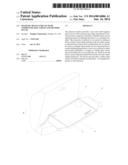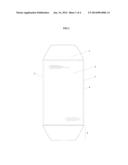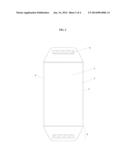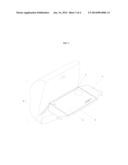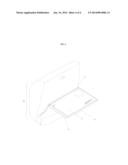Patent application title: Hygienic Device for Use with Commuter Tray Tables and Method of Use
Inventors:
Douglas Clatterbuck (Orlando, FL, US)
IPC8 Class: AA47G1100FI
USPC Class:
108 90
Class name: Horizontally supported planar surfaces plural related horizontal surfaces detachable enlarging or substitute surface
Publication date: 2014-01-16
Patent application number: 20140014006
Abstract:
The present invention provides a new and useful hygienic device for use
with commuter tray tables and method of use. The invention comprises a
plurality of flexible layers and an attaching means for adhering the
device to a commuter tray table. This invention is believed to be useful
by offering a device which is removeably attached to the tray table,
creates a solid protective barrier from contaminants, has an absorptive
layer to mitigate liquid spills, has non-slip properties to combat
shifting during motion, is low cost, conforms to safety and security
guidelines, is compact or folded when stored, and can be disposed of or
recycled after use. While in use the device creates a physical barrier
between the user and a septic surface during use. The device also
provides a surface upon which a decorative element can be printed--for
example text, picture or advertisement.Claims:
1. A hygienic device for use with commuter tray tables comprising: a) a
plurality of layers including at least a base layer and surface layer,
said layers each cut into a generally two-dimensional geometric shape
having a plurality of edges including at least one distal edge and one
proximal edge, said base layer is made of a moisture impermeable
material, said base layer also having at least two alate features or
flaps along the edges, said surface layer is affixed atop the base layer
and is made of a moisture absorptive material; b) an attaching means
affixed to the bottom surface of the flaps for removeably attaching the
device to a commuter tray table in the environment; and c) a stitching
means, said stitching means attaching the layers together and creating a
seam that runs approximately parallel to and along at least one edge of
the surface layer.
2. A device as in claim 1 further comprising a plurality of interior layers, said interior layers affixed between the surface layer and base layer.
3. A device as in claim 1 further comprising the placement or printing of a decorative element on any exterior layer of the device.
4. A hygienic device for use with commuter tray tables comprising: a) a base layer cut into a generally two-dimensional geometric shape having a plurality of edges, said base layer having a plurality of flaps along the edges and an attaching means affixed to the bottom surface of the flaps for removeably attaching the device to a commuter tray table in the environment.
5. The device as in claim 4 wherein the base layer is made of moisture impermeable material.
6. The device as in claim 4 wherein the attaching means is tape, glue, or any adhesive material.
7. The device as in claim 4 further comprising a surface layer on top of the base layer, said surface layer cut into a generally two-dimensional geometric shape having a plurality of edges.
8. The device as in claim 7 wherein the surface layer is made of moisture absorptive material.
9. The device as in claim 7 further comprising a plurality of interior layers between the base layer and the surface layer.
10. The device as in claim 7 further comprising a stitching means along the edges of the device, said stitching means attaching the base layer and surface layer together and creating a seam that runs approximately parallel to and along the edges of the surface layer.
11. The device as in claim 7 further comprising the placement or printing of a decorative element on the exterior of any layer of the device.
12. The device as in claim 9 wherein any layer is impregnated with a fragrant and/or anti-bacterial agent.
13. The device as in claim 10 wherein the stitching means is not applied along one edge of the device, thereby creating a pocket between the base layer and surface layer, said pocket serving as an alternative attachment mechanism whereby the device slides over the commuter tray table like a sleeve.
14. The device as in claim 10 wherein the device is disposable.
15. The device as in claim 10 wherein the device is recyclable.
16. A method of use for the device as in claim 1 comprising: a) selecting a seat on a commuter vehicle; b) lowering a commuter tray table usually affixed to the rear of a seat in front of the passenger; c) unfolding the device; d) placing the device on the commuter tray table with base surface side down; e) orienting the device to have the proximal edge closest to the passenger; f) folding the flaps around the sides of the tray table; g) adhering the device to the tray table by fixing the attaching means to the bottom of the tray table; h) keeping the device affixed to the tray table throughout the duration of travel or intended use; and i) removing the device from the tray table when finished.
17. A method of use for the device as in claim 4 comprising: a) selecting a seat on a commuter vehicle; b) lowering a commuter tray table usually affixed to the rear of a seat in front of the passenger; c) unfolding the device; d) placing the device on the commuter tray table with base surface side down; e) orienting the device to have the proximal edge closest to the passenger; f) folding the flaps around the sides of the tray table; g) adhering the device to the tray table by fixing the attaching means to the bottom of the tray table; h) keeping the device affixed to the tray table throughout the duration of travel or intended use; and i) removing the device from the tray table when finished.
Description:
CROSS-REFERENCE TO RELATED APPLICATIONS
[0001] Not Applicable.
STATEMENT REGARDING FEDERALLY SPONSORED RESEARCH OR DEVELOPMENT
[0002] Not Applicable.
REFERENCE TO SEQUENCE LISTING, A TABLE, OR A COMPUTER PROGRAM LISTING COMPACT DISK APPENDIX
[0003] Not Applicable.
TECHNICAL FIELD
[0004] The present invention is in the technical field of hygienic devices. More particularly, the present invention is in the technical field of hygienic devices for commuter travel. More particularly, the present invention is in the technical field of hygienic devices for use with commuter tray tables.
BACKGROUND OF THE INVENTION
[0005] Commuter travel, particularly that in passenger airlines and trains, is an integral part of the global business and vacation experiences. These experiences often require the commuter or passenger to share cramped communal spaces with other travelers in passenger compartments, seats and terminals. Because of the close proximity and the often-wearing experience of travel, concern for individual health arises. Exposure to bacteria, antigens and other illness inducing vectors from fellow travelers and the septic environment can cause a passenger to become ill. This reality of modern travel has led to the creation of an industry centering on hygienic devices, whereby a passenger can more easily limit contamination or exposure to infection. Some such examples of these devices are small portable containers of antibacterial gels and wipes. These devices are aimed for intermittent use and temporary cleaning by the user. However in many situations, semi-permanent barriers are preferable. Semi-permanent barriers are those that create a physical barrier between the user and a septic surface during protracted use. Semi-permanent barriers like toilet seat covers and placemats have already shown their worth in high traffic travel areas. More semi-permanent barriers like these are necessary in the current travel experience.
[0006] Currently there is a need for a hygienic device for use with commuter tray tables often found on the backs of seats in passenger planes and trains. In the inventor's experience, passenger tray tables accumulate and retain germs, dirt, food particles, dried liquids and other residuals throughout the day. This debris is directly related to repeated passenger use combined with tight schedules for airlines. It is simply not possible for attendants to inspect and clean every tray table between flights.
[0007] In the inventor's experience, passengers try to mitigate this problem in the current art by bringing pre-moistened wipes as part of their travel accoutrement. It is not wholly effective and does not cure the problem in the current art. Most commonly, not all passengers carry the wipes or similar devices--often asking for the same from others or the attendants. Those that do carry the wipes or bottles of gel can also experience the scrutiny of airport screening and security--many times having to discard them before boarding a plane. Finally after use, the volume of discarded used wipes only adds to the debris in the cabin.
[0008] In the inventor's experience there is a need for a hygienic device for use with commuter tray tables that creates a solid protective barrier from contaminants, that has an absorptive layer to mitigate liquid spills, that has some non-slip properties to combat shifting during motion, that is low cost, conforms to safety and security guidelines, and can be disposed of or recycled after use.
[0009] There is a travel tray liner disclosed in U.S. Pat. No. 7,976,099 B2. This invention comprises a tray liner of flexible construction that relies on the rigid airline or railroad car seat tray underneath it to create a horizontal clean and sanitary surface useful for supporting food and drink utensils.
[0010] This invention does not address the problem in the art successfully. Primarily it is a rigid tray with a rigid lip surrounding it. It is not compact, easy to store or discard. It is also intended for the limited use by toddlers in flight or on high chairs. This invention is more so a parenting aid than one concerned with hygiene, flexible use and disposability.
[0011] There is also a disposable cover for diaper changing station and method of use disclosed in US Patent Application Publication No.: US/2009/0126118 A1. This invention concerns itself with providing a sanitary barrier between the child and the horizontal and vertical surfaces of the diaper changing station. Although this invention is concerned with hygiene it is not intended for use in airline cabins, or on passenger tray tables. This device too is a parental aid and does not teach nor address the concerns of the present invention and art.
[0012] In the applicant's experience there is a need for a hygienic device for use with commuter tray tables and method of use which: i) is removeably attached to the tray table, ii) creates a solid protective barrier from contaminants, iii) has an absorptive layer to mitigate liquid spills, iv) has non-slip properties to combat shifting during motion, v) is low cost, vi) conforms to safety and security guidelines, vii) is compact or folded when stored, and viii) can be disposed of or recycled after use.
SUMMARY OF THE INVENTION
[0013] The present invention provides a new and useful hygienic device for use with commuter tray tables which is removeably attached to the tray table, creates a solid protective barrier from contaminants, has an absorptive layer to mitigate liquid spills, has non-slip properties to combat shifting during motion, is low cost, conforms to safety and security guidelines, is compact or folded when stored, and can be disposed of or recycled after use. The device also provides a surface upon which a decorative element can be printed for example text, picture or advertisement.
[0014] In one of its basic embodiments the present invention comprises a plurality of layers including at least a base layer and surface layer. Each layer is cut into a generally two-dimensional geometric shape having a plurality of edges including at least one distal edge and one proximal edge. The base layer is made of a moisture impermeable material such as vinyl or plastic and has at least two alate features or flaps along the edges. The surface layer is affixed atop the base layer and is made of a moisture absorptive material such as cloth or paper. An attaching means is affixed to the bottom surface of the flaps for removeably attaching the device to a commuter tray table in the environment. The attaching means can be tape, adhesive, or an equivalent. A stitching means attaches the base layer and surface layer together and creates a seam that runs approximately parallel to and along at least one edge of the surface layer.
[0015] When in use, the user selects a seat on a commuter vehicle, which can be a plane, train or equivalent. Next, the user or passenger lowers a commuter tray table usually affixed to the rear of a seat in front of her. The user then unfolds the device and places it on the commuter tray table with base surface side down. The passenger orients the device to have the proximal edge closest to her. The user then folds the flaps around the sides of the tray table. The user then adheres the device to the tray table by fixing the attaching means to the bottom of the tray table. The passenger keeps the device affixed to the tray table throughout the duration of travel or the intended use. Finally the user removes the device from the tray table when finished. Optionally, the user may discard, retain or recycle the device after use. Throughout the entirety of use, the user never has to touch the tray table or debris with their bare hands--thereby minimizing germ exposure.
[0016] Thus the present invention is believed to provide a new and useful hygienic device for use with commuter tray tables and method of use which: i) is removeably attached to the tray table, ii) creates a solid protective barrier from contaminants, iii) has an absorptive layer to mitigate liquid spills, iv) has non-slip properties to combat shifting during motion, v) is low cost, vi) conforms to safety and security guidelines, vii) is compact or folded when stored, and viii) can be disposed of or recycled after use.
[0017] Further features and objectives of the present invention will become apparent from the following detailed descriptions and the accompanying drawings.
BRIEF DESCRIPTION OF THE DRAWINGS
[0018] FIG. 1 is a top view of the device according to the present invention;
[0019] FIG. 2 is a bottom view of the device according to the present invention;
[0020] FIG. 3 is a view of an embodiment of the present invention being used in its environment, specifically, being attached to a commuter tray table;
[0021] FIG. 4 is a view of an embodiment of the present invention being used in its environment, specifically, attached to a commuter tray table for use.
DETAILED DESCRIPTION OF THE INVENTION
[0022] As described above, the present invention provides a new and useful hygienic device for use with commuter tray tables which is removeably attached to the tray table, creates a solid protective barrier from contaminants, has an absorptive layer to mitigate liquid spills, has non-slip properties to combat shifting during motion, is low cost, conforms to safety and security guidelines, is compact or folded when stored, and can be disposed of or recycled after use.
[0023] Referring now to the invention in more detail, in FIG. 1 and FIG. 2 there is shown a hygienic device for use with commuter tray tables. The device comprises a plurality of layers including at least a base layer 1 and surface layer 2. Each layer is cut into a generally two-dimensional geometric shape having a plurality of edges including at least one distal edge 3 and one proximal edge 4. The base layer is made of a moisture impermeable material such as vinyl or plastic and has at least two alate features or flaps 5 along the edges. The surface layer 2 is affixed atop the base layer 1 and is made of a moisture absorptive material such as cloth or paper. An attaching means 6 is affixed to the bottom surface of the flaps 5 for removeably attaching the device to a commuter tray table in the environment. The attaching means 6 can be tape, adhesive, or an equivalent. A stitching means 7 attaches the base layer 1 and surface layer 2 together and creates a seam that runs approximately parallel to and along at least one edge of the surface layer 2.
[0024] The dimensions of the device can be any size--as dictated by the corresponding commuter tray table used in the plane or train. It is envisioned that one embodiment will have a surface layer 2 that is approximately sixteen inches wide and approximately ten inches long between the proximal edge 4 and distal edge 3. It is envisioned that the base layer 1 will generally correspond to the dimensions of the commuter tray table and the surface layer 2. In one embodiment, it is envisioned that the flaps 5 will extend laterally from the base layer 1; and each flap 5 will measure approximately two inches long or as required to fold under and attach to the commuter tray table.
[0025] In one embodiment of the invention the stitching means 7 is not applied along one edge of the device, thereby creating a pocket between the base layer 1 and the surface layer 2. The resultant pocket serves as an alternative attachment mechanism whereby the device slides over the commuter tray table like a sleeve.
[0026] In another embodiment of the device, a decorative element can be placed or printed on any exterior layer of the device. The decorative element can be a pattern, text, image, advertisement or an equivalent.
[0027] In an alternate embodiment of the device, a plurality of interior layers can be affixed between the base layer 1 and the surface layer 2.
[0028] In an alternate embodiment of the device any layer can be impregnated with a fragrant and/or anti-bacterial agent.
[0029] Referring now to FIG. 3 and FIG. 4, the device is shown in its environment when in use. This embodiment of the present invention is positioned upon a commuter tray table. To use the device, the user selects a seat on a commuter vehicle, which can be a plane, train or equivalent. Next, the user or passenger lowers a commuter tray table usually affixed to the rear of a seat in front of the passenger. The user then unfolds the device and places it on the commuter tray table with base surface 1 side down. The passenger orients the device to have the proximal edge 4 closest to her. The user then folds the flaps 5 around the sides of the tray table. The user then adheres the device to the tray table by fixing the attaching means 6 to the bottom of the tray table. The passenger keeps the device affixed to the tray table throughout the duration of travel or the intended use. Finally the user removes the device from the tray table when finished. Optionally, the user may discard, retain or recycle the device after use.
[0030] Although the present invention has been described in considerable detail with reference to certain preferred versions thereof, other versions are possible. Therefore the spirit and scope of the appended claims should not be limited to the description of the preferred versions contained therein.
[0031] The reader's attention is directed to all papers and documents which are filed concurrently with this specification and which are open to public inspection with this specification, and the contents of all such papers and documents are incorporated herein by reference.
[0032] All the features disclosed in this specification may be replaced by alternative features serving the same, equivalent or similar purpose, unless expressly stated otherwise. Thus, unless expressly stated otherwise, each feature disclosed is one example only of a generic series of equivalent or similar features.
[0033] While the foregoing written description of the invention enables one of ordinary skill to make and use what is considered presently to be the best mode thereof, those of ordinary skill will understand and appreciate the existence of variations, combinations, and equivalents of the specific embodiment, method, and examples herein. As for "means for" elements, the applicant intends to encompass within the language any structure presently existing or developed in the future that performs the same function. The invention should therefore not be limited by the above described embodiment, method, and examples, but by all embodiments and methods within the scope and spirit of the invention.
User Contributions:
Comment about this patent or add new information about this topic:

